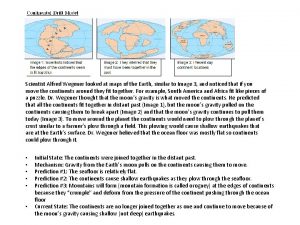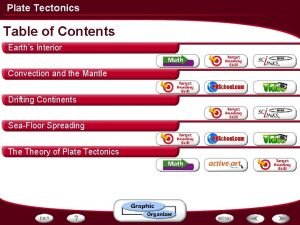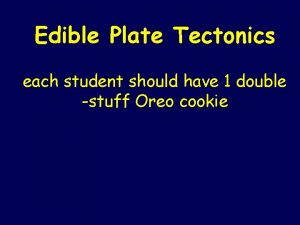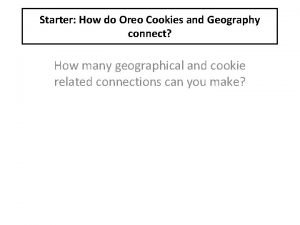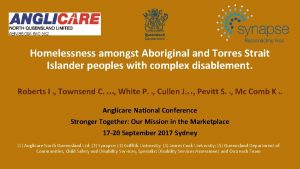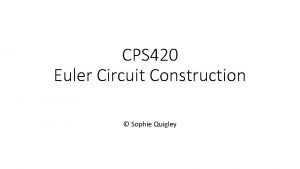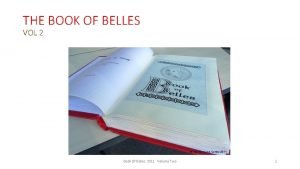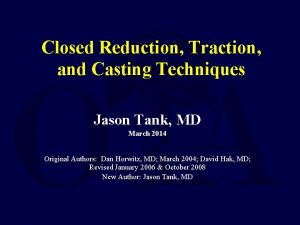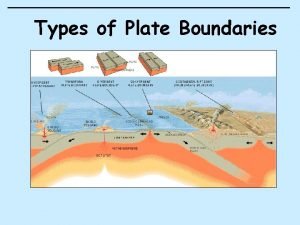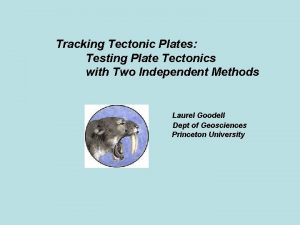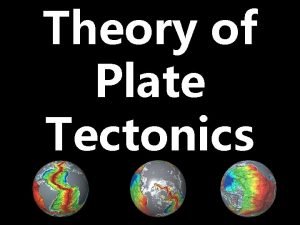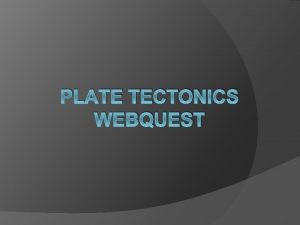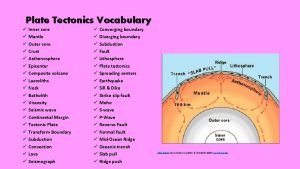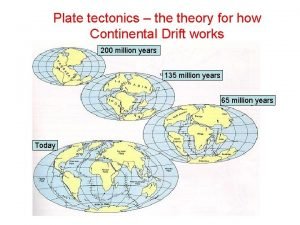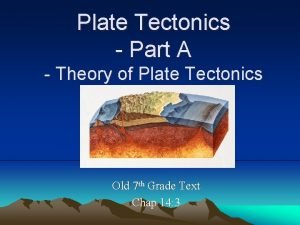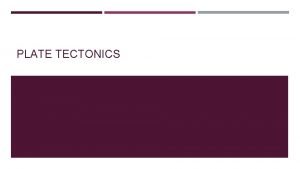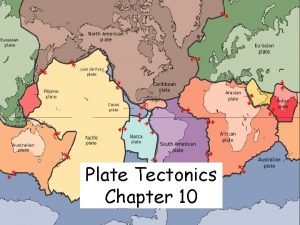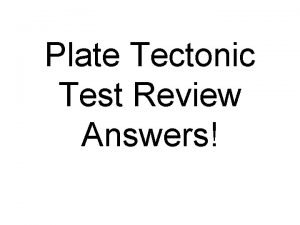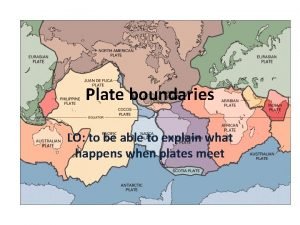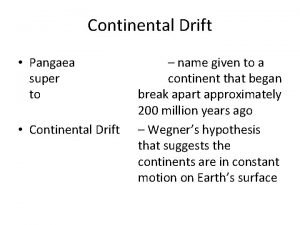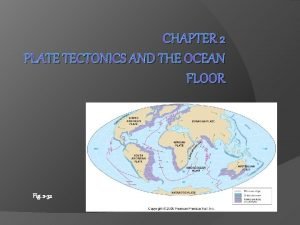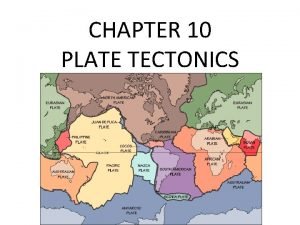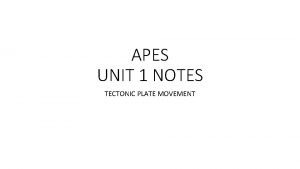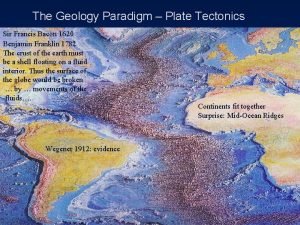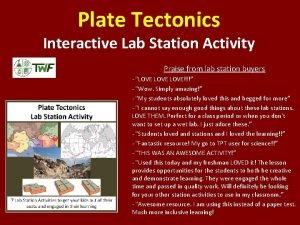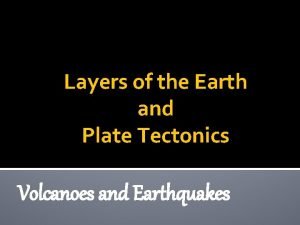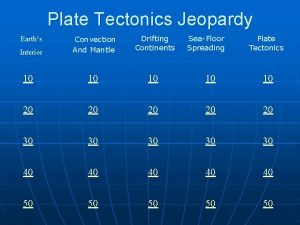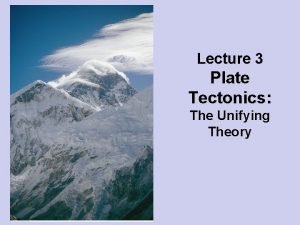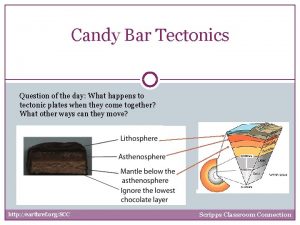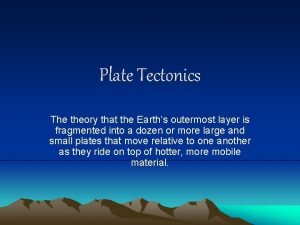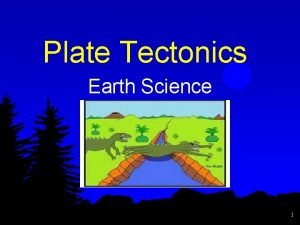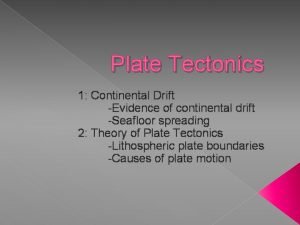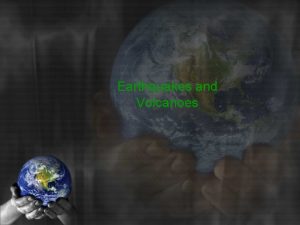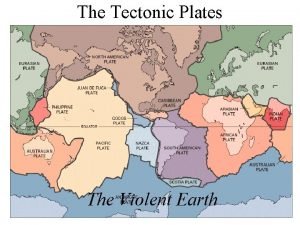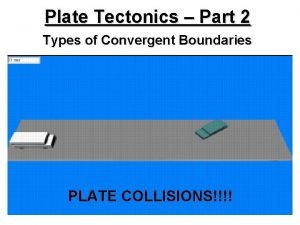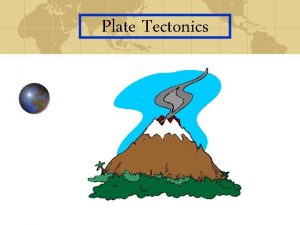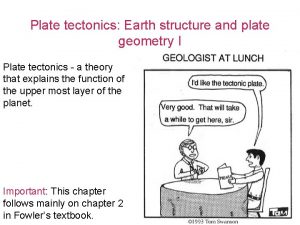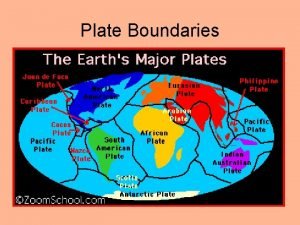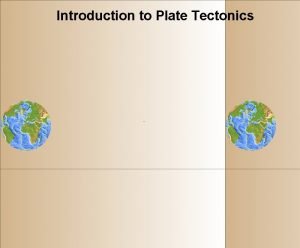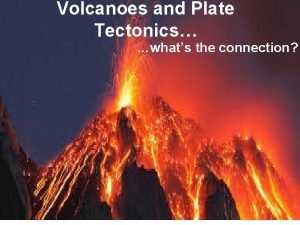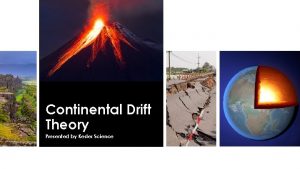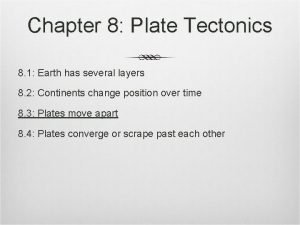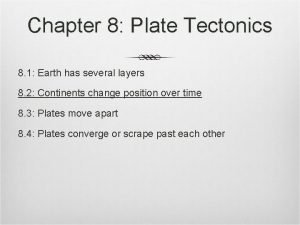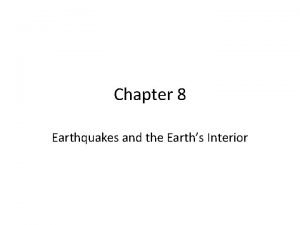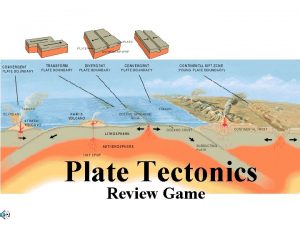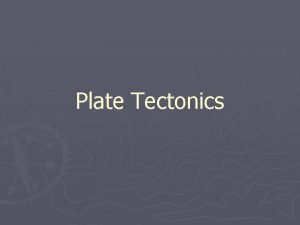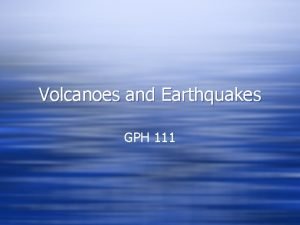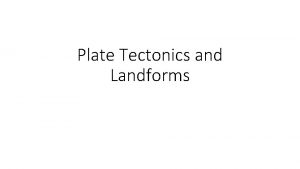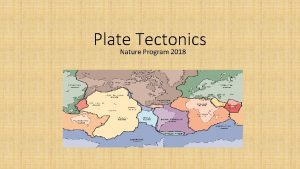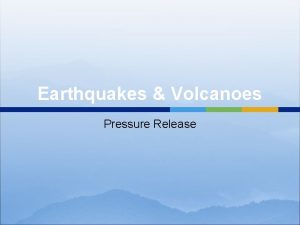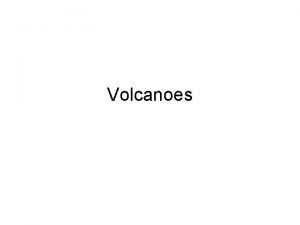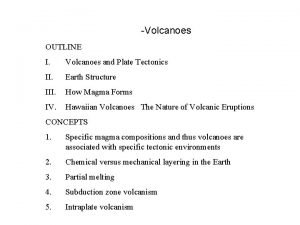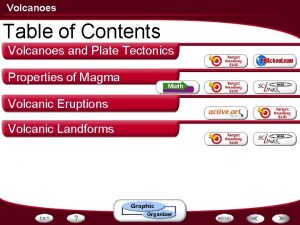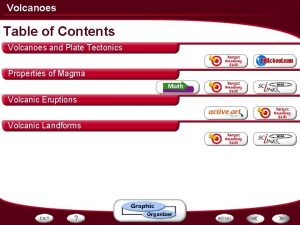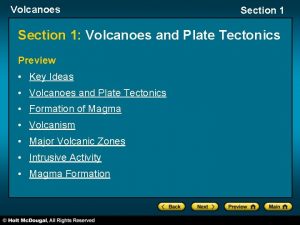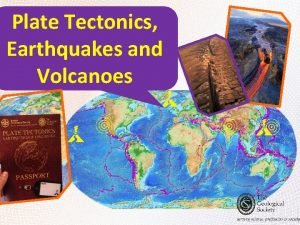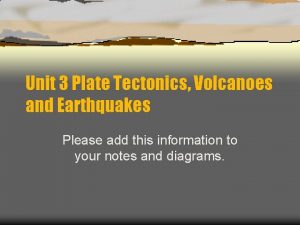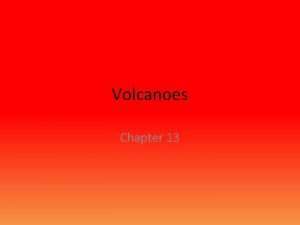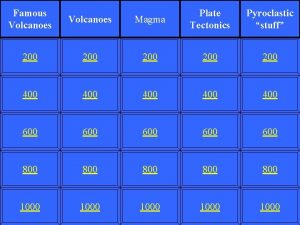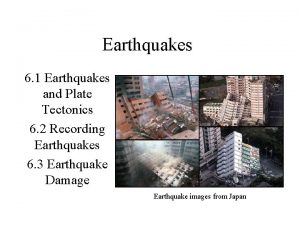Plate Tectonics Earthquakes and Volcanoes J Quigley Plate





















































- Slides: 53

Plate Tectonics, Earthquakes and Volcanoes J. Quigley

Plate Tectonics • Plate tectonics is a discovery that revolutionized the field of geology! • Plate tectonics is theory that pieces of the earth’s lithosphere, called plates, move about slowly on top of the asthenosphere

Plate Tectonics • Plate tectonics explains the formation and movement of earth’s plates. • Until plate tectonics were understood, geologists couldn’t explain how fossils from ocean creatures were found on mountain tops, how mountains and valleys… • Plate tectonics explain earthquakes and volcanoes… it is amazing!!

Continental Drift • A German scientist hypothesized in 1912 that the continents were once joined together in a single supercontinent, which then broke into pieces and moved apart… called Pangaea.

Continental Drift • Fossils of land based plants and animals were discovered on continents separated by large oceans… these fossils puzzled geologists until continental drift and plate tectonics were understood

Continental Drift • Continental drift explains how continents move slowly across earth’s surface. It explains why continents seem to fit together and it explains why there are fossils all over the globe that are similar

Sea-Floor Spreading • Geologist Harry Hess proposed theory of sea floor spreading. • Sea-floor spreading is the process by which new oceanic crust is created at mid-ocean ridges as older crust moves away

Mid-Oceanic Ridge • The mid-ocean ridge is a huge crack in the crust where magma pushes upward. • Pieces of the ocean floor on either side of the mid-ocean ridge are moving slowly apart.

Formation of Oceanic Crust • As the ocean floor moves magma from the mantle wells up and solidifies to form new oceanic crust.

Subduction of Oceanic Plates • As sea-floor spreading occurs old oceanic plates sink into the mantle in the process of subduction. • As a plate sinks through a subduction zone, it bends, forming a depression in the ocean floor called a trench

Subduction of Oceanic Plates • Sea floor spreading creates new oceanic crust at mid ocean ridges. Subduction destroys old oceanic crust at subduction zones

Evidence for Sea-Floor Spreading • Rocks were sampled on both sides of the midocean ridge and they found patterns of parallel magnetic “stripes” that were identical on the two sides • The stripes exist because Earth’s magnetic field has reversed itself many times in the past • The stripes showed that new ocean floor was being added to both sides of the mid-ocean ridge at roughly the same rate.

Theory of Plate Tectonics • According to theory: Earth’s plates are constantly moving, each with a different rate and direction. • Convection currents form in the mantle as hot rick rises at mid-ocean ridges, cools and spreads out horizontally as ocean lithosphere, and then sinks back into the mantle at subduction zones. • These sinking slabs of dense lithosphere and heat from within Earth drive the circulation of convection currents in the mantle. • Plate motions are the visible part of the process of mantle convection.

Plate Boundaries • There are thee types of plate boundaries –Divergent boundaries –Convergent boundaries –Transform boundaries

Divergent Boundaries • Plates move away from each other at a divergent boundary • When plates diverge (move away from each other) magma rises from the mantle to fill the gap. Magma cools to form new rock at the edge of each plate.

Convergent Boundaries • When plates come together or collide they are convergent. • The most common convergent boundary is one where an oceanic plate is subducted beneath a trench. When oceanic crust collides with continental crust, the denser oceanic crust slides under the continental crust

Transform Boundaries • Plates slide past each other, moving in opposite directions. • Rock is neither created or destroyed at a transform boundary

Mountain Building • Geologists have found that most mountains form along plate boundaries.

Earthquakes

EARTHQUAKES • An earthquake is movement of Earth’s lithosphere that occurs when rocks in the lithosphere suddenly shift, releasing stored energy. • When energy is released during an earthquake it is carried by vibrations called seismic waves.

Earthquakes • As tectonic plates move, • http: //www. youtube. co they cause stress in the m/watch? feature=playe crust, which in turn r_embedded&v=o_9 XH produces faults and nvy. UJU#t=0 s folds

Earthquakes • A fault is a break in a mass of rock along with movement occurs. • Two slabs of rock on either side of a fault move in relation to each other • Many faults occur along plate boundaries

Earthquakes • A fold is a bend in layers of rock • Forms form where rocks are squeezed together, but do not break • Rocks tend to fold rather than break when they are under high temperature or pressure • Folds can vary greatly in size

Seismic Waves • Earthquakes occur because stress forces have exceeded the strength of rock • The location beneath Earth’s surface when an earthquake begins is called the focus • The location on earth’s surface directly above the focus is the epicenter

Seismic Waves • As an earthquake occurs, seismic waves move out in all directions from the focus

Types of seismic waves • P waves- primary waves are longitudinal waves similar to sound waves. They compress and expand the earth like an accordion. They are also the fastest seismic waves and travel large distances quickly. They travel through solids and liquids.

Types of seismic waves • S waves- secondary waves are transverse waves. They cause the particles in the materials they pass through to vibrate at right angles to the direction the waves move. They move like a waving flag. They travel through solids only.

Types of Seismic Waves • Surface Waves- waves that develop when seismic waves reach earth’s surface. They move more slowly than the other waves. They usually produce large ground movements and greater damage.

Measuring Earthquakes • To measure earthquakes and pinpoint their epicenters, geologist record seismic waves using a seismograph • Seismograph- a device that can detect and record seismic waves.

Seismographic Data • Most earthquakes are concentrated along plate boundaries, where many faults are found. • Some earthquakes are in the interior of plates • Scientists have mapped earth’s interior, analyzing how seismic waves move through its layers

Seismographic Data • The speeds of seismic waves and the paths they take are affected by the temperature, composition and density of the rocks they pass though. • Geologists infer that Earth’s outer core is liquid because S waves cannot pass through it • They can also tell the core is mostly iron because P waves travel through it at a speed that matches laboratory experiments on iron.

Volcanoes

Formation of a Volcano • Under certain conditions, small amounts of mantle rock can melt, forming liquid magma. The magma rises upward through the crust, erupting at the surface as a volcano.

How a Volcano Erupts • The process is similar to if you quickly open a bottle of soda that has been shaken. • Magma is under pressure and contains dissolved gasses, as magma approaches the surface, lower pressure allows the gases to expand rapidly. • An eruption occurs when the gases bubble out through a crack in the crust, propelling magma to the surface

Structure of a Volcano • Before an eruption, magma usually collects in a pocket called a magma chamber • Magma slowly accumulates in the magma chamber until enough pressure builds up to start an eruption

Structure of a Volcano • Then, magma rises to the surface in a narrow, vertical channel called a pipe

Structure of a Volcano • An opening in the ground where magma escapes to the surface is called a vent • There is often one central vent at the top of a volcano, but sometimes there are vents that open along the side of the volcano

Structure of a Volcano • At the top of the central vent of most volcanoes is a bowl shaped pit called a crater

Structure of a Volcano • After an eruption, a volcano’s magma chamber and main vent may be empty of magma creating a hollow shell. If the shell collapses inward, it creates a huge depression called a caldera, at the top of the volcano

Eruptions • Volcanoes erupt explosively or quietly, depending on the characteristics of the magma • Magma varies in viscosity (thickness) based on temperature, water content and silica content

Quiet Eruptions • Volcanoes that have very hot, low silica magma general erupt quietly. In a quiet eruption lava is of low viscosity and flow great distances.

Quiet Eruptions • They produce two types of lava – Hot, fast moving with rope like surface called pahoehoe (pah HOH ee hoh ee)

Quiet Eruptions • Cooler, slow moving lava with a chunky crumbly appearance is called aa (Ah ah)

Explosive Eruptions • High silica magma produces explosive eruptions. Thick magma can clog a volcanic pipe, causing enormous pressure to build up. When the volcano finally explodes, lava and hot gasses are hurled outward.

Explosive Eruptions • Explosive eruptions have particles that get thrown through the air. Some particles are small like ash, some are pebble sized… and occasionally, chunks of lava the size of a small car can be thrown!

Location and Types of Volcanoes • Most volcanoes occur along plate boundaries or at hot spots in the crust • Volcanoes often form along converging plate boundaries where an oceanic plate is subducted into the mantle. The plate sinks through the mantle and is melted. Magma forms and rises to the surface • Volcanoes can also form along diverging plate boundaries where magma rises to fill the gap between two separating plates.

Ring of Fire • Volcanoes forming along the trenches that rim the pacific ocean

Hot Spots • Some volcanoes form in hot spots… a region where hot rock extends from deep within the mantle to the surface. • Hot spots are responsible for building the Hawaiian islands.

Types of Volcanoes • Shield Volcano- a quiet eruption of low viscosity lava produces a wide, flat volcano.

Types of volcanoes • Cinder Cone- if an eruption is entirely ash and cinders, the result will be a small, steepsided volcano

Types of Volcanoes • Composite Volcano- A volcano that forms from explosive eruptions that produce a combination of lava and ash.

Other Igneous Features • Igneous features formed by magna include batholiths, sills, dikes and volcanic necks.

THE END
 Chapter 8 earthquakes and volcanoes
Chapter 8 earthquakes and volcanoes Compare continental drift and plate tectonics
Compare continental drift and plate tectonics Compare continental drift and plate tectonics
Compare continental drift and plate tectonics Seafloor spreading material at trenches
Seafloor spreading material at trenches Plate tectonic theory vs continental drift
Plate tectonic theory vs continental drift Oreo tectonics
Oreo tectonics Oreo objectives
Oreo objectives Quigley street cairns
Quigley street cairns Sophie quigley
Sophie quigley Eva quigley
Eva quigley How to apply skin traction
How to apply skin traction Plate tectonics vs continental drift
Plate tectonics vs continental drift What are the four types of boundaries
What are the four types of boundaries Evidence of the theory of plate tectonics
Evidence of the theory of plate tectonics Plate tectonics theory states that
Plate tectonics theory states that Plate tectonics webquest pdf
Plate tectonics webquest pdf Plate tectonics vocabulary
Plate tectonics vocabulary Continental drift
Continental drift Plate tectonics definition
Plate tectonics definition Driving force of plate tectonics
Driving force of plate tectonics Concept map plate tectonics
Concept map plate tectonics Summarize the theory of plate tectonics
Summarize the theory of plate tectonics Arthur holmes contribution to plate tectonics
Arthur holmes contribution to plate tectonics Mantle magma
Mantle magma Collision plate boundaries
Collision plate boundaries Pangaea
Pangaea From now
From now Fossils as evidence of continental drift
Fossils as evidence of continental drift Plate tectonics apes
Plate tectonics apes Francis bacon plate tectonics
Francis bacon plate tectonics Plate tectonics interactive lab
Plate tectonics interactive lab Convergent plate boundary
Convergent plate boundary Oreo plate tectonics
Oreo plate tectonics Types of volcanoes
Types of volcanoes Plate tectonics game board
Plate tectonics game board Unifying theory of plate tectonics
Unifying theory of plate tectonics Candy bar tectonics
Candy bar tectonics Plate tectonics
Plate tectonics Plate tectonics
Plate tectonics Plate tectonics
Plate tectonics Plate tectonics
Plate tectonics San andreas fault
San andreas fault Boundaries of plate tectonics
Boundaries of plate tectonics Juan de fuca plate
Juan de fuca plate Earth rotation
Earth rotation Future plate tectonics
Future plate tectonics Theory of plate tectonics
Theory of plate tectonics Strombolian eruption
Strombolian eruption Plate tectonics jeopardy
Plate tectonics jeopardy Kesler science plate boundaries
Kesler science plate boundaries Chapter 8 plate tectonics
Chapter 8 plate tectonics Chapter 8 plate tectonics
Chapter 8 plate tectonics Chapter 8 section 1 what are earthquakes
Chapter 8 section 1 what are earthquakes Chapter 8 earthquakes and earth's interior
Chapter 8 earthquakes and earth's interior


